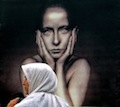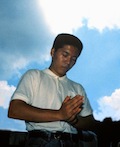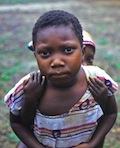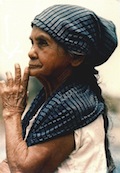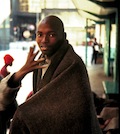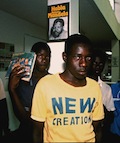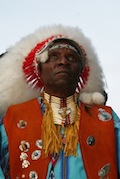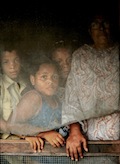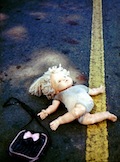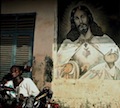
Dr. Spruill, born in Plymouth, North Carolina is a photographer, scholar, educator, theologian, and community activist. These photographs are reflective of his thirst for new perspectives on the human condition. For forty years he has quietly photographed his unique life’s journey. His academic and pedagogical achievements are public record and have stood the test of time. His doctoral thesis on photojournalism has been used in award-winning documentaries and historical publications. He chose to be a member of the academy without an institutional assignment. His commitment to serving small communities with the skills and gifts of doctoral training is an unusual sacrifice in our day. For decades these private images were shared with intimate family, friends, local photographers and artists. WHOSE EYES ARE OPEN, a forty-year retrospective book of photographs allows everyone who desires - to see the world as he does. He is currently a professor at Morehouse College in Atlanta, Georgia and is writing a cookbook and novel about the early African presence in Westchester County, New York.
For more information Contact Us: info@larryspruill.net
All Images and Original text Copright 2012 - Larry H. Spruill
Dr. Spruill (LHS) became interested in photography in 1968 while a student at the State University of New York at Stony Brook. He is an award-winning photographer and has been exhibited in major galleries. The following interview with William Thomas (WT) of the Association of Community-Based Artists of Westchester (AC-BAW) Gallery for an exhibition catalog illustrates Dr. Spruill’s philosophy about the art of photography.
WT: What are the qualities that make a great photographer?
LHS: Great photographers love people and telling visual stories. I want to tell special stories about the human condition. I care about people because God cares. My mission is to visualize people struggling with life and marginalization. I always carry a camera because making thoughtful photographs requires passion and preparedness. My opportunities to fully explore camera vision have been sporadic. By the way, “camera vision” is the freedom to see the world through the lens of a camera. I am always ready to scan my world for soulful images. Camera vision is about looking closely at my daily environment. Great photographs consistently come out of the skill and life of camera vision.
WT: Over the past thirty years, which is your most significant photograph?
LHS: I believe my most satisfying images are yet to be crafted. My most popular images are those of African people. My most personal and meaningful pictures are those that explore human marginality. Only a few of my photographs have been commercially published but I do believe that I have images of enduring interest and value.
WT: When or how did you discover your passion for photography?
LHS: I was a history major at SUNY at Stony Brook. In the fall of 1970, the late Professor Hugh Cleland saw my potential as a member of the academy. I was on my way to southwest Georgia to meet my wife’s family. I had never been that far south. I was a young student with fresh memories of the assassination of Dr. King and the Civil Rights confrontations. Dr. Cleland gave me a camera. This began my interest in documentary photography. He took me to camera clubs where I learned the fundamentals of composition, exposure and how to tell a story on 35mm strips of plastic. He personally introduced me to Willard Van Dyke, a professor who studied with Edward Weston. I later met the African-American elder statesmen of photography James VanDerZee, P.H. Polk and Gordon Parks.
Dr. Cleland later served on my doctoral committee. My dissertation, Southern Exposure, Photojournalism and the Civil Rights Movement, 1954-1968, was the first study of professional civil rights photojournalists. It remains the seminal work on the subject. So, from the gift of a camera for a trip South to a Ph.D. dissertation about American photojournalism, Dr. Cleland influenced my intellectual and aesthetic life.
WT: Have you had other teachers or mentors who touched your life as a photographer?
LHS: Donald Robertson, a phenomenal painter and illustrator, taught me what it meant to be an artist and to think and see creatively. He exposed me to the power and appropriate use of color and its influence on the eye and mind. He also introduced me to the spiritual dimensions of art. The late George Wilson, a great classical American painter befriended me and taught me about the role of art in ones local community. George painted children in the South Bronx. Urban streets and parks were his studio.
My doctoral research introduced me to America’s great photojournalists. I developed a long-term relationship with Flip Schulke, the most prolific photographer of Dr. Martin Luther King, Jr. He taught me about the use of photography to tell complex social and political stories, as well as its influence on public opinion. I am still discovering my personal vision while learning from everyone I can. Photographing life is a wonderful way of knowing oneself.
WT: What kind of photographs are you making these days?
LHS: I am working on a series of global urbanscapes. These pictures help me build a personal bridge between photography and painting. They are my still-lifes. They are inanimate, but time, weather conditions, and people’s hands change their content and meaning on a daily basis. They are found objects waiting for me to enter their space. I have photographed poster bills, walls and urbanscapes on nearly every continent. This project is a work in progress.
WT: What do you do when you are not taking pictures?
LHS:
I try to keep track of the new technologies. I spend time looking at thousands of my images in my DVD archives. I am still committed to film but I am also rethinking what my older images can say in the digital age. I have been using a Macintosh computer for fifteen years. The power of digital darkroom tools is revolutionary. I recently began using digital cameras. I am not quite happy with my results. Digital is the future of photography. The learning curve is huge. We are all prisoners of time. I do digital photography because I must. Who wants to be left behind?
WT: What makes a photographer a talented artist?
LHS: Talented photographers master visual literacy. They are about thoughtful seeing. They see what most do not. Artists have their own visions. What separate photographers are their skills making compelling narratives on 35mm strips. This is difficult. It is not about equipment. It is about a ravenous mind and heart. The digital revolution is redefining fine art photography. I am not particularly interested in the debate. Technology has made it easy to get correct exposure, image sharpness and the appropriate use of shades of gray, as well as millions of colors. These tools do not require talent. Creative gifts are internal, matters of the soul. I am interested in creative picture making.
WT: What part of the photographic process do you love most?
LHS: There is no greater thrill than releasing the shutter at the “decisive moment” knowing you have captured the desired content of your visual narrative. Making stimulating pictures is an ecstatic experience. I love what I call “photo-talk.” Talking about pictures requires sharing images with friends, foes and strangers. Exhibitions are necessary in the sharing process. I have had my share. I have sold pictures. Making my pictures available to a broad viewing audience helps create the bitter and sweet dialogue artists need to grow. I look forward to photo-talk about Whose Eyes Are Open.
WT: Do you do your own processing and printing?
LHS:
Years ago, darkroom experience was a prerequisite to calling yourself a photographer. I work in color. Today, I get them commercially processed and digitized on disc. These allow me more time to work on writing about my work; seeking new exhibition venues; and of course, time to explore the new technologies. Making interesting pictures takes time. Who has the time, budget, and space to chemically process film and print pictures? The digital darkroom is manageable, affordable and available. The quality is improving and costs are dropping every six months. This is the way to go from camera to prints for the present and future.
WT: What is the greatest obstacle in your work as a photographer?
Nothing takes the place of taking pictures. To make good pictures, I need time to spend on camera vision. Time allows a photographer to fully work a motif or concept. It takes time to satisfy the creative urge. It is impossible to be all the photographer you can be working at the “post office” - what ever your “post-office” may be. The freedom to create is driven by the amount of time and sense of security from fear of loss of food and shelter one possesses. Modern patrons for photographers are rare. Support for emerging ethnic photographers is a deeper issue. I am in a race with time and mortality. These are enormous obstacles. They are always there. If I am to be remembered for my pictures, I must actively work to overcome all the things that come between photography and me.
WT: Which pictures bring you the most personal satisfaction?
LHS: I believe my best pictures are yet to be made, I have three pictures that are special to me. They combine my quest for thoughtfulness with a critical or “decisive moment” in the picture-making process. For example, “As A Roaring Lion” was taken in Long Beach, California. I saw doll parts in an abandoned storefront window. Using a 24mm lens, I positioned myself to get a good composition. I made several pictures. Suddenly, a cat appeared in the frame. I made one picture. It was at the critical moment. His paw had a slight motion toward the doll heads. The image had tension, a sense of pending danger. The cat was the predator. The dolls were the prey. I used a scripture from 1 Peter 5:8 as the caption. “Be sober, be vigilant; because your adversary the devil, as a roaring lion, walked about, seeking whom he may devour.” In 1982, I was doing New York City street photography. I was beginning my work on urban billboards. At a construction site at 14th Street and Union Square I saw a poster that appeared to be a man from the Neolithic age. The light streaming through the scaffolding made a diagonal line toward the street. I patiently waited for the right moment. A man walked through the frame. Bam! I made the image. I knew it was the frame I was waiting for. A day later, I got the chrome back from the lab. I was not disappointed. It was an exciting Twilight Zone moment.
On 15th Street near Union Square Park, I saw a panhandler soliciting coins. I scanned him and the background posters into my viewfinder. I could not resist the “he wants you to have his baby” signage for the movie “Paternity.” I fired off a few frames. They were mediocre images. I stayed with the photo-story. Moments later, a petite, attractive woman briskly walked through my set and frame. The woman in the blue jacket wrote the closing lines for the picture. Her speedy exit said “no” to this preposterous proposition. The story was on a single strip of 35mm film. For a moment, I knew what it was like to be Stephen King and Steven Spielberg. It was exhilarating.
WT: Your subjects seem to be on the fringes of society, are you concerned about them?
LHS: I am an observer, a travelling visual griot (a West African storyteller). I make pictures that place people in their world as I encountered them. They are anonymous people, with real lives. I am attracted to them because they are marginal. They are not people passing through my life. I am walking on the edge of their complex and troubled existence. I established personal contact with some of them, many I did not. I hope people see and feel their vulnerability and condition in my pictures. I want viewers to think and care about my photographed people, places and things. I want viewers to experience the storyline, no matter how simple. I try to photograph people through the lens of my heart and mind. Compassion is at the heart of “concerned photographers.” I pray that I am such a photographer.
WT: Tell us more about your experiments with photography and painting?
LHS: I have been photographing billboards and urban signage transformed by acts of time and nature. It is not a unique motif. When I started, I thought it was. Walker Evans photographed signage in the 1930s. I recently saw similar images by Beuford Smith and Ralph Gibson, two of my favorite photographers. My interest is in the content within the colorful fragments. This project helps me satisfy my frustrated ambition to be a painter. I have scanned the walls of cities all over the world looking for images and stories.
In 1994, I was in Accra, the port capital of Ghana. The region between the broiling Sahara and Atlantic Ocean is called The Sahel. It was a typical hot West African day. I was at the harbor waiting for the returning fishermen. I knew there would be lots of pictures amidst the busy wholesale and retail transactions. Until then, I had to wait. I sat under the shade of the wooden boats lined along the shore. I put my camera down and thought about where I was and other possibilities of telling a different kind of West African story. In the stillness of the moment I noticed my colorful surroundings.
I began photographing the boats docked for painting and repair. The older boats had been painted many times. Most had been scrapped, exposing layers of paint. As I moved in closer, I saw brilliant colors, forms, and shapes. I saw a small area of black paint soaring through what I imagined to be a blue sky above the West African coastline. It was as a winged Ashanti angel carrying out its celestial duties throughout Mother Africa. It reminded me that God still cared about the Garden of Eden. Lesson learned: in creative dry spells, there are yet powerful images awaiting the attention of “light writers,” -- photographers. It is important to be still, listen and see with open eyes.
"Seraphim Over the Sahel" is one of my favorite images. It was there for anyone willing to stop and see. This painting from life was copyright free. It spoke to my soul. It continues to take me back to a moment of solitude in which I discovered the importance of meditation and conversations with oneself. There is so much to see and hear. On that day, my eyes were opened to the endless possibilities of picture making.
WT: Your use of scriptures as captions for pictures is interesting. What is the point?
LHS: Art like love is divine. I am created in the image of the God. As a photographer, I make images of God’s creation. I am like God. I have the ability to imagine and bring the vision to artistic life. I am an artist and Christian. My faith also governs how I see the world. There are critics who think that there is no such creature as a modern Christian artist? They are wrong. Being a Christian does not limit my creative expression. In fact, active faith opens me to even greater creativity. Photographing God’s people, places and things allows me to better understand the sacred and divine. I am working on visualizing my faith in ways in which hopefully non-Christians can appreciate. Only the scriptures support the divine power and perfection of nature. Images and scripture help me to do that.
For example, I have photographed beautiful sunsets on the Zambezi River near the misty roar of Musiotunya, “smoke with thunder,” a.k.a, Victoria Falls. I remember photographing the perpetual rainbow of hope over the Falls. This noisy awesome wonder of the world declared itself to be the site of the very presence of God. I was convinced that God is the Master Artist-Creator. My well exposed photographs were just low resolution copies of the originals. They were not works of art but mere record shots. There are numerous Psalms that describe the natural handiwork of God. They make excellent captions.
WT: Are the majority of your photographs reflective of your faith?
LHS: No. But they are reflective or representative of my consciousness at the time the picture was made. My pictures represent autobiographical statements about various phases in my life. For many years I was a Muslim. There were years when my thinking was dominated by radical social and political ideologies. We live, learn, grow and shift our world-view along the way. So, Whose Eyes Are Open is about my encounter with our delightful and often dangerous world. I am still learning to see life with faithful eyes and a camera. Thousands of frozen filmed moments help me to remember and savor the beauty, the brutality, as well as the hope of life.
WT: Why is photography one of the visual arts?
LHS: Humans are artful. I am enchanted by camera vision. It is a satisfying way of life. Art is about our personal vision and voice. Everyone has something meaningful to say. We can speak through our creative eyes. Photography enables me to go beyond primitive seeing to thoughtful scanning. I am still learning how to enable my eyes, mind and heart to work together to make meaningful pictures. I am refining this skill. Every picture reflects the uniqueness of a personal purpose and moment in time. A picture is my a record of my particular place and time as well as a reflection of my values and motivations. This is true for every person using a camera. Our pictures are personal. We are our pictures. Art is an expression of thoughtfulness. Art is about being human. Photography helps me to be more human, an artist. Photography, if not art, is certainly a useful tool for artists.
WT: Are you a “Black Photographer”?
LHS: After meeting the acclaimed Harlem photographer, James VanDerZee, I founded a club in his name. It held workshops conducted by African-American photographers, Roy DeCarava, John Shearer, Jean Moutousamay-Ashe, Beuford Smith and Frank Stewart. Their images were close to my cultural milieu. I discovered the reality of cultural eyes. As a person of African descent, I have little choice other than to filter my photography through my ethnic heart, my community and into the world. I refuse to reject my heritage. I also refuse to be labeled and bound by it. My DNA and cultural baggage are always close by. They are home. I always keep home within sight.
WT: How does this notion of revelation relate to “camera vision” or photography?
LHS: Good photography like other art forms is primarily inspirational or metaphysical. Photography has enriched my life. Pictures that go beyond vanity into revelation about human nature are not controlled by style or technique. Revelation is gained by conscious seeing, meditation and experience.
Camera vision is a liberating experience. Images that provide revelation are those that move photographers and viewers from speculation to certainty about the invisible and silent. When my inward visual sensors are activated, I become an archeologist sifting through the soil of life, hoping to find meaning about people, places and things. There are "eureka" experiences in photography. I believe I have found enough of them to share.
WT: Are you a “concerned photographer”?
LHS: In a photojournalistic sense, no. Photographers have played an important role in opening public eyes to injustice, human suffering and war. I am concerned about humanity. Whose Eyes Are Open is not a journalistic record. It does, hopefully, stimulate compassion and understanding of the human condition. My pictures are forces for love and peace in the world. I want others to see the frailty of the human family, the tenderness of the earth and the vanity of things. I am no afraid to see and attempt to visualize the invisible, the forgotten and if possible, the future. Human development and progress happens with ones eyes open. I am alive and working toward that goal. I desire nothing more than to be among those Whose Eyes Are Open.
WT: Thank you Dr. Spruill.
LHS: You are most welcome.
